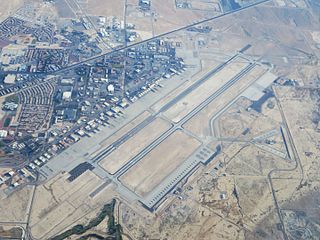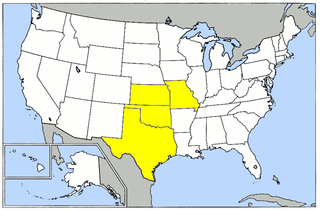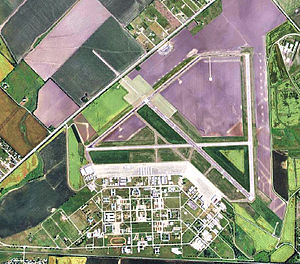
Nellis Air Force Base is a United States Air Force installation in southern Nevada. Nellis hosts air combat exercises such as Exercise Red Flag and close air support exercises such as Green Flag-West flown in "Military Operations Area (MOA) airspace", associated with the nearby Nevada Test and Training Range (NTTR). The base also has the Combined Air and Space Operations Center-Nellis.

Randolph Air Force Base was a United States Air Force base located at Universal City, Texas.

Dobbins Air Reserve Base or Dobbins ARB is a United States Air Force reserve air base located in Marietta, Georgia, a suburb about 20 miles (32 km) northwest of Atlanta. Originally known as Dobbins Air Force Base, it was named in honor of Captain Charles M. Dobbins, a World War II C-47 pilot who died near Sicily.

Mather Air Force Base was a United States Air Force Base, which was closed in 1993 pursuant to a post-Cold War BRAC decision. It was located 12 miles (19 km) east of Sacramento, on the south side of U.S. Route 50 in Sacramento County, California. Mather Field was one of 32 Air Service training camps established after the United States entry into World War I in April 1917.

Waco Regional Airport is five miles northwest of Waco, in McLennan County, Texas. It is owned by the City of Waco.

Sewart Air Force Base (1941–1971) is a former United States Air Force base located in Smyrna, about 25 miles southeast of Nashville, Tennessee. During World War II, it was known as Smyrna Army Airfield.

Ellington Field Joint Reserve Base is a joint installation shared by various active component and reserve component military units, as well as aircraft flight operations of the National Aeronautics and Space Administration (NASA) under the aegis of the nearby Johnson Space Center. The host wing for the installation is the Texas Air National Guard's 147th Attack Wing. Opened in 1917, Ellington Field was one of thirty-two Air Service training camps established after the United States entry into World War I. It is named for First Lieutenant Eric Ellington, a U.S. Army aviator who was killed in a plane crash in San Diego, California in 1913.

Marshall Army Airfield (MAAF) is a military airfield located on Fort Riley, Kansas, United States. It was opened in 1921. The primary mission of MAAF is to provide fully integrated fixed base helicopter operations for the Combat Aviation Brigade, 1st Infantry Division.

Bakalar Air Force Base is a former U.S. Air Force base located 4.4 miles (7.1 km) northeast of Columbus, Indiana. During World War II, the base was known as Atterbury Air Field and Atterbury Army Air Base, but it was renamed Bakalar Air Force Base in 1954 in honor of First Lieutenant John Edmond Bakalar, USAAF. Established in 1942, the airfield served as a training base for medium-range C-46 Commando and C-47 Skytrain troop carrier planes and glider pilots. It also was used for training B-25 Mitchell and B-26 Marauder bomber crews. Reactivated during the Cold War, it was used as an Air Force Reserve training base for troop carrier, tactical airlift, and special operations flying units. The military base was closed in 1970. The present-day facility operates as the Columbus Municipal Airport.
During World War II, the United States Army Air Forces (USAAF) established numerous airfields in Wyoming for training pilots and aircrews of USAAF fighters and bombers.

Cross City Air Force Station is a former United States Air Force facility, located 1.6 miles (2.6 km) east of Cross City, Florida.

Flying Division, Air Training Command, was a training formation of the United States Air Force. The unit was established in 1926 as the Air Corps Training Center to be the primary pilot training center for the Air Corps. It was reorganized into one of three training commands created by the Office of the Chief of the Air Corps in 1940 to accommodate the large number of air cadets being recruited as a result of the expansion of the corps after the fall of France. During World War II, thousands of cadets attended various flight schools throughout the Central United States being trained as pilots for fighters, bombers and transports. It also trained the navigators, bombardiers and gunners necessary for the bombers to attack enemy targets in the combat areas overseas. After World War II, it became the primary pilot and aircrew training unit of the United States Air Force Air Training Command.

Aiken Air Force Station is a closed United States Air Force General Surveillance Radar station. It is located 6.4 miles (10.3 km) north-northeast of Aiken, South Carolina. It was closed in 1975.

The 32d Flying Training Wing is an inactive United States Air Force unit. It was last assigned to the Central Flying Training Command, and was disbanded on 13 October 1946 at the Randolph Field, Texas.

The 35th Flying Training Wing is an inactive United States Air Force unit. It was last assigned to the Western Flying Training Command, and was disbanded on 16 June 1946 at the Minter Field, California.

The 38th Flying Training Wing is an inactive United States Air Force unit. It was last assigned to the Western Flying Training Command, and was disbanded on 16 June 1946 at Williams Field, Arizona.

The 34th Operations Group is an inactive United States Air Force unit. It was first activated as the 34th Flying Training Wing and supervised training of bombardiers and pilots for multiengine aircraftuntil it was disbanded on 16 June 1946 at Midland Army Air Field, Texas. The wing was reactivated in 1978 as the 34th Tactical Airlift Training Group and conducted various courses for crews of the Lockheed C-130 Hercules until inactivating in December 1961. It was activated a third time in 1994 as the 34th Operations Group and conducted airmanship training at the United States Air Force Academy.

The 80th Flying Training Wing was a training wing of the United States Army Air Forces. It was last assigned to the Central Flying Training Command, and was disbanded on 16 June 1946 at Ellington Field, Texas.

Cannon Air Force Base is a United States Air Force Base, located approximately 7 miles (11 km) southwest of Clovis, New Mexico. It is under the jurisdiction of Air Force Special Operations Command (AFSOC). The host unit at Cannon is the 27th Special Operations Wing, which activated on 1 October 2007, and is assigned to the Air Force Special Operations Command (AFSOC). The 27 SOW plans and executes specialized and contingency operations using advanced aircraft, tactics and air refueling techniques to infiltrate, exfiltrate and resupply special operations forces (SOF) and provide intelligence, surveillance and reconnaissance and close air support in support of SOF operations.

Webb Air Force Base, previously named Big Spring Air Force Base, was a United States Air Force facility of the Air Training Command that operated from 1951 to 1977 in West Texas within the current city limits of Big Spring. Webb AFB was a major undergraduate pilot training (UPT) facility for the Air Force, and by 1969, almost 9,000 pilots had been trained at Webb. The last operational wing at Webb AFB was the 78th Flying Training Wing.























